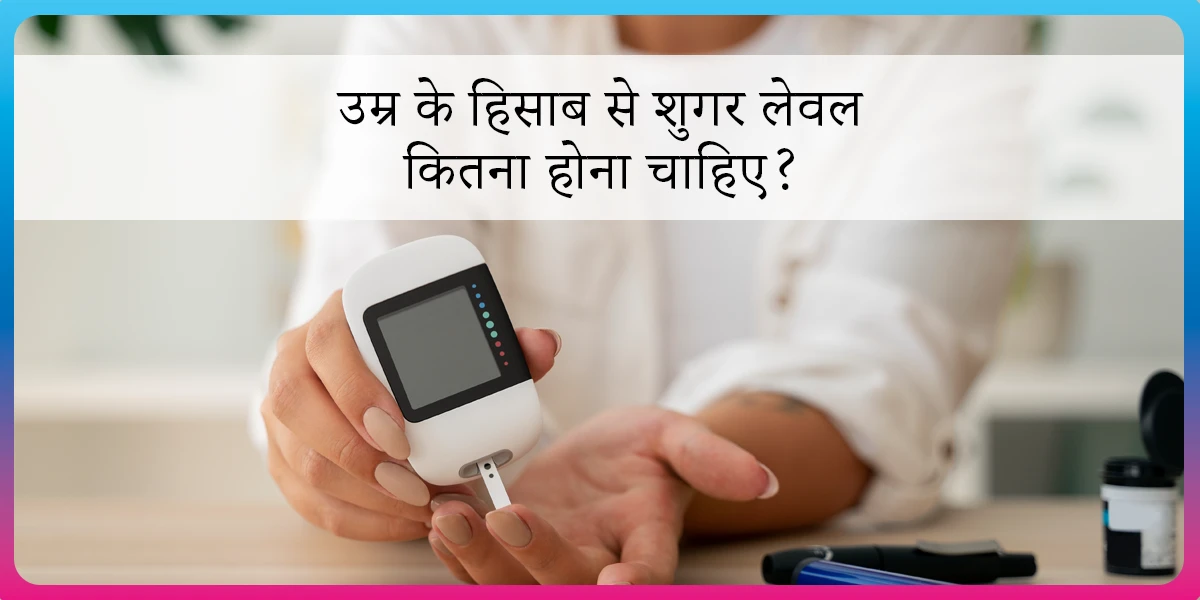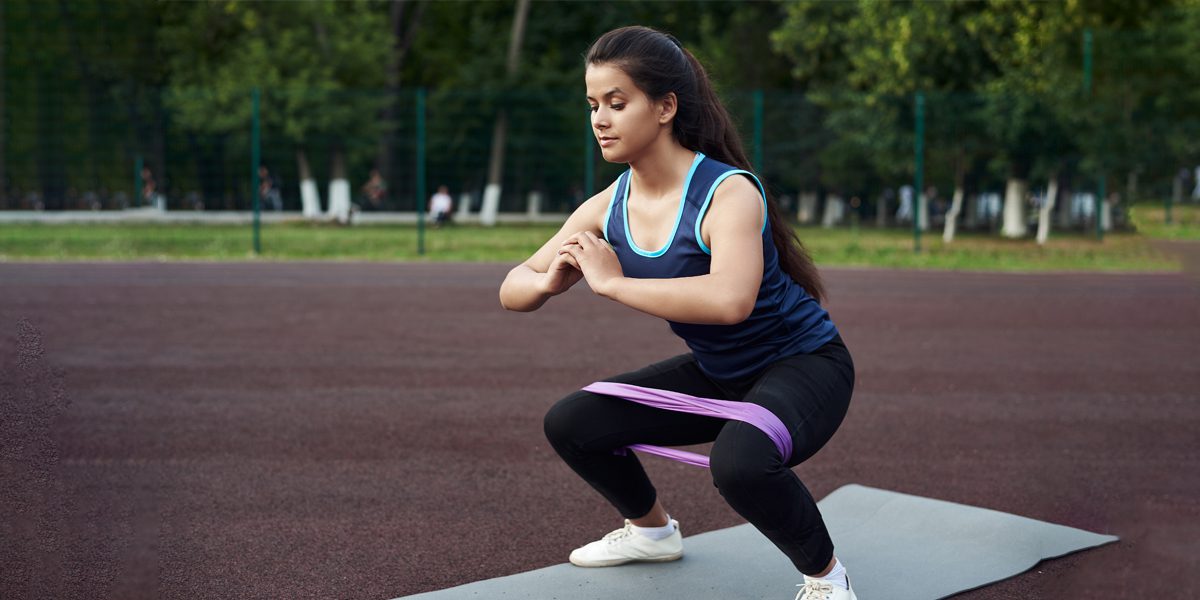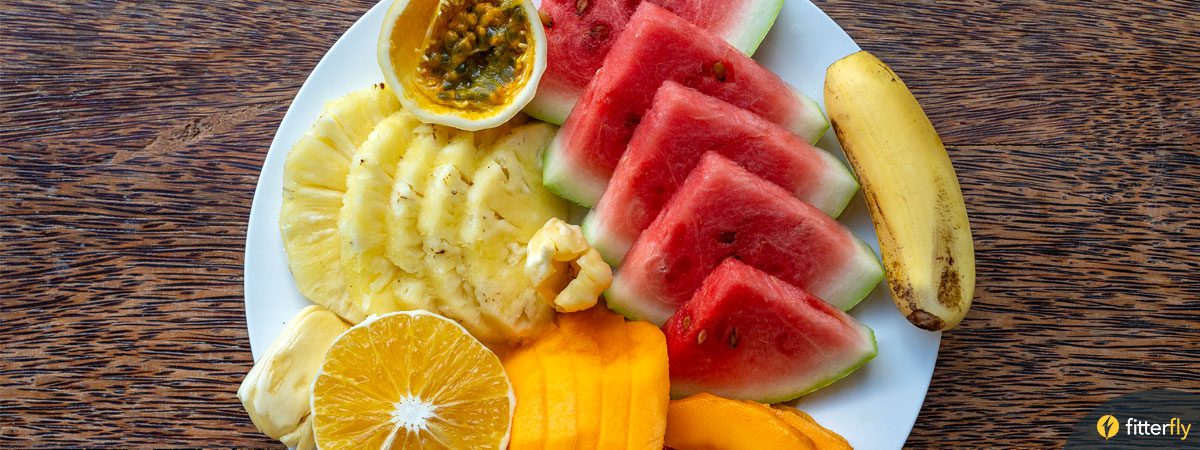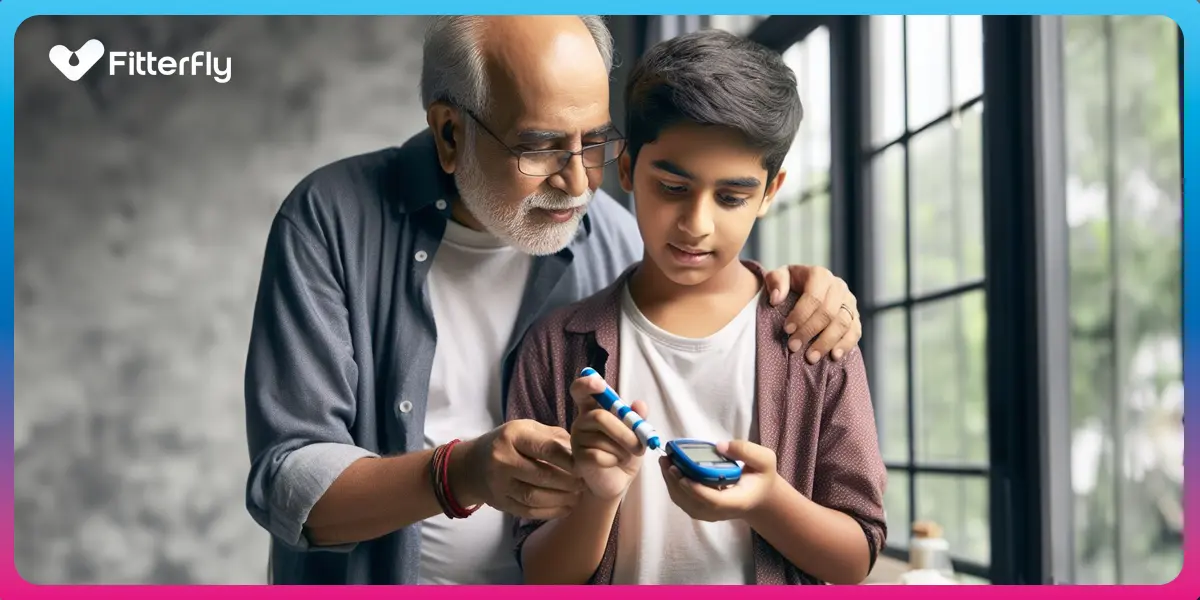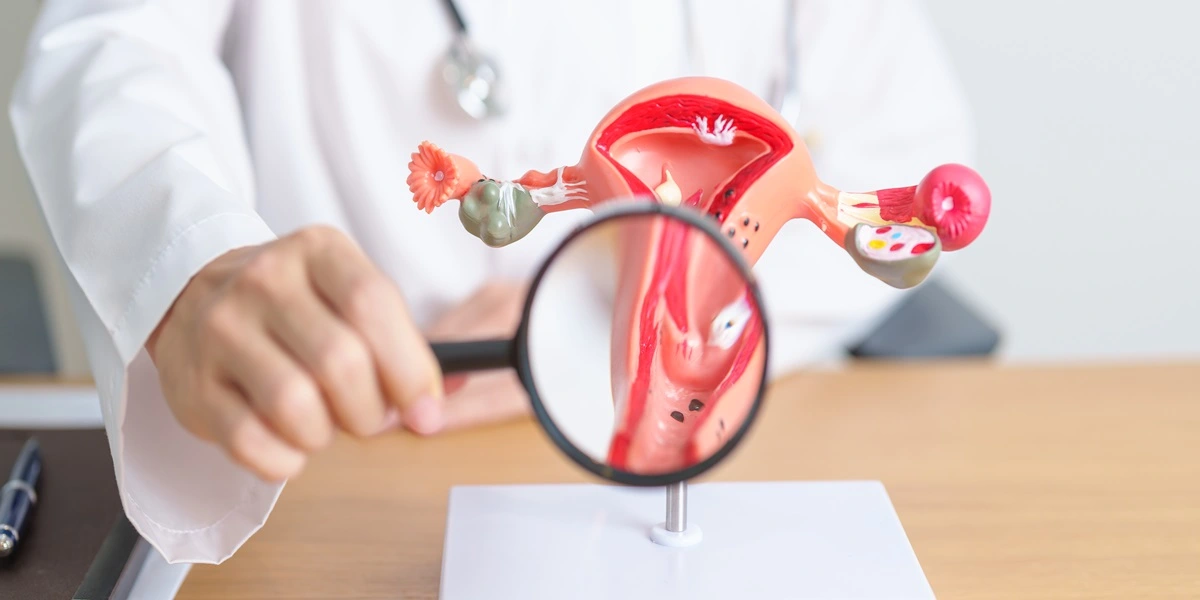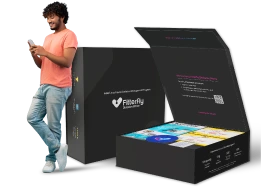What is Personalised Glycemic Response?
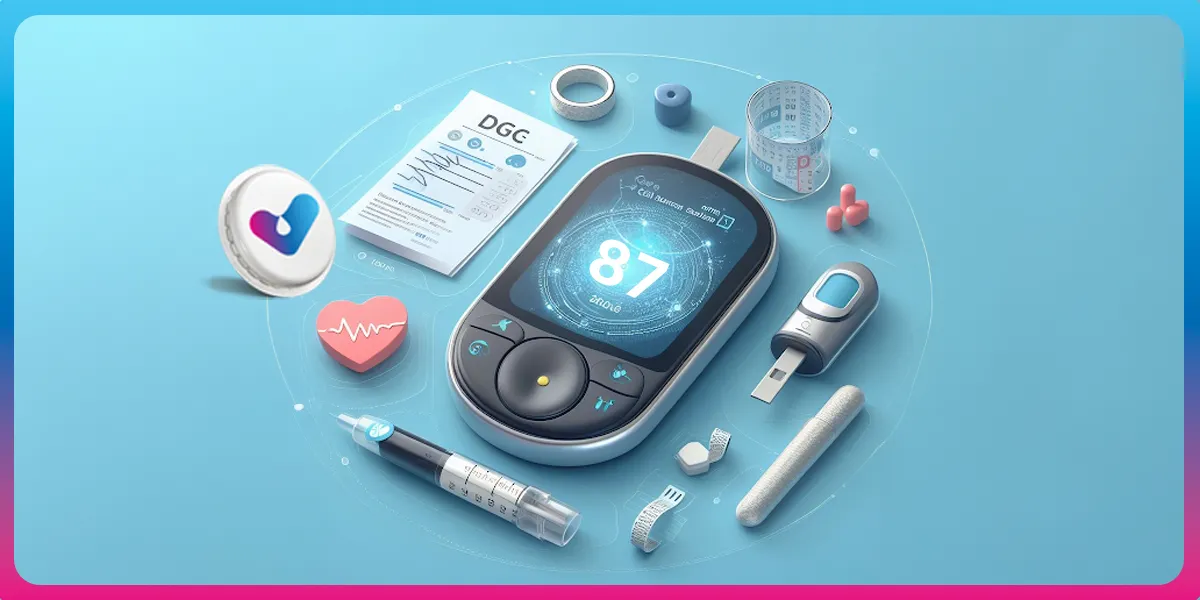
Parth, a 38-year-old diamond merchant, was recently diagnosed with diabetes. The moment his family and friends heard the news, advice started pouring in:
❌ “Stop eating rice – roti is better!”
❌ “No more mangoes for you!”
❌ “Switch to millets, wheat is bad!”
Parth felt lost. Everyone had a different opinion, but no one could tell him what would actually work for his body. Frustrated, he turned to his doctor and dietitian for answers. That’s when they introduced him to Personalized Glycemic Response (PGR), a scientific way to understand how HIS body reacts to different foods he eats.
If you’re like Parth – confused by all the advice or hearing about PGR for the first time, you’re in the right place. Keep reading.
What is Glycemic Response?
Before we understand PGR, we need to take a step back and understand what Glycemic Response is. The food you eat has different types of nutrients like carbohydrates, fibre, fats, proteins etc. Now, Whenever you eat, the carbohydrates in your food break down into glucose (sugar), which enters your blood. Some foods cause a quick rise in blood sugar, while others lead to a gradual, steady increase.
Glycemic Response (GR) refers to how your blood sugar changes after eating. It depends on several factors, such as:
- Type of carbohydrate: A bowl of white rice with dal may cause a faster blood sugar rise than a bowl of brown rice or quinoa and dal, along with vegetables and salad, which has more fiber and protein to slow the absorption of glucose.
- Portion size: Eating four rotis at once will likely raise blood sugar more than eating two rotis along with sabzi, dal, and salad, which balance the meal.
- Food combinations: A plain poha can lead to a sugar spike, but adding peanuts, sprouts, and vegetables can slow it down by increasing protein and fiber.
Since everyone’s glycemic response is unique, the same food may affect different people differently and that is what Personalized Glycemic Response (PGR) is. It helps you find out which foods keep your blood sugar stable so you can enjoy meals that work best for you!
What is Personalized Glycemic Response (PGR)?
Just as every person is unique, their response to food varies too.
- Two people can eat the exact same meal, but their blood sugar levels may rise differently. This happens because each person’s body processes carbohydrates uniquely, influenced by factors like metabolism, gut health, insulin sensitivity, physical activity, stress levels and even genetics.
- Personalized Glycemic Response (PGR) is an approach that helps determine how YOUR body responds to different foods. Instead of following generic diet rules – like “rice is bad” or “millets are best” – PGR helps identify which foods help maintain stable blood sugar and which ones cause spikes for you specifically.
How Does PGR Work?
- Tracking Blood Sugar: Using a Continuous Glucose Monitoring System (CGMS) or structured glucose testing, PGR assesses how different foods impact your blood sugar.
- Identifying the Right Foods: For example, white rice with dal might be just fine for your blood sugar levels, but for someone else, it may cause a spike and you need to pair it with extra protein or fiber.
- Making Smarter Adjustments: Instead of eliminating foods, PGR helps optimize portion sizes, meal combinations, and timings to keep blood sugar levels stable.
Why is Knowing Your PGR Important?
Managing diabetes can be confusing, especially with generic advice that may not work for everyone. Personalized Glycemic Response (PGR) helps you understand how your body reacts to different foods, making diabetes management simpler and more effective.
1. Diabetes Management is Not One-Size-Fits-All
Generic advice like “avoid carbs” or “switch to millets” doesn’t work for everyone. PGR tailors food choices to your body’s needs, leading to better blood sugar control.
2. No Unnecessary Food Restrictions & Easy Meal Planning
Many people stop eating their favourite foods out of fear. PGR helps you enjoy them safely by adjusting portion sizes, food combinations, or meal timing. It also removes confusion by offering clear, data-backed meal plans.
3. Keeps Blood Sugar Stable & Reduces Health Risks
Frequent sugar spikes can lead to nerve damage, kidney problems, and heart disease. PGR helps prevent these complications by identifying foods that keep your blood sugar steady.
4. Improves Energy & Well-Being
Stable blood sugar means more energy, better sleep, and fewer mood swings. PGR helps you avoid sugar crashes, keeping you active and feeling good throughout the day.
5. A Scientific, Data-Driven Approach
Instead of guessing what works, PGR relies on real-time blood sugar monitoring to create a plan that’s personalized and backed by science, leading to faster and more effective diabetes control.
What are the Factors that Affect Personalized Glycemic Response (PGR)?
Everyone’s blood sugar reacts differently to the same food. While one person may experience a sharp spike after eating rice, another might have a stable response. This variation happens due to several factors that influence Personalized Glycemic Response (PGR).
1. Type and Composition of Food
- Carbohydrate Type: Simple carbs like sugar and white rice digest quickly, leading to rapid blood sugar spikes, whereas complex carbs like whole grains and legumes digest more slowly.
- Protein and Fats: These slow down the digestion of carbohydrates, helping to moderate blood sugar levels.
- Fiber Content: High-fiber foods, such as vegetables and whole grains, delay glucose absorption, preventing sudden spikes.
2. Portion Size
Consuming large portions, even healthy foods, can lead to higher blood sugar levels due to excessive carbohydrate intake.
17 Tips to Avoid Overeating
3. Food Combinations
Eating carbohydrates alone raises blood sugar faster than pairing them with protein, fiber, or healthy fats, which help slow glucose absorption.
4. Cooking Method
How food is prepared affects blood sugar response. Fried foods (e.g., fried potatoes) may spike blood sugar faster than boiled or steamed alternatives due to loss of water content and higher fat absorption. Overcooked or highly processed foods can also break down faster, leading to quicker glucose release.
5. Meal Timing and Frequency
The body’s ability to regulate blood sugar fluctuates throughout the day. Some people experience higher sugar spikes in the morning, while large or late-night meals can lead to prolonged high blood sugar levels.
6. Physical Activity Levels
Regular movement improves insulin sensitivity, helping the body use glucose efficiently. A sedentary lifestyle can lead to higher blood sugar spikes after meals.
7. Stress and Sleep
High-stress levels trigger cortisol release, which can raise blood sugar. Poor sleep reduces insulin sensitivity and may lead to higher fasting blood sugar levels.
8. Gut Health and Digestion
The gut microbiome affects how the body processes carbohydrates. An imbalance in gut bacteria can contribute to insulin resistance and unpredictable blood sugar responses.
9. Hydration Levels
Dehydration can concentrate blood sugar, making it harder for the body to regulate glucose effectively.
10. Individual Metabolism and Genetics
Genetics, age, and hormonal balance influence how carbohydrates are processed, leading to variations in blood sugar response between individuals.
By understanding these factors, you can make informed food choices to keep blood sugar levels stable and manage diabetes more effectively.
REAL EXAMPLE of How PGR Helps
Let us explain how knowing his PGR score helped one of our Diabetes Prime Program members Mr Rajesh Sahu*.
One of the days, his breakfast was just a large bowl of peas (matar) poha without peanuts. Here’s what happened to his blood sugar after having it:
- Before eating: His blood sugar was 122 mg/dL
- 1 hour after eating: It spiked to 217 mg/dL
- PGR Score: 6

Why This Spike Is a Problem?
When you eat anything, your blood sugar rises naturally. This is normal. However, for people with diabetes, it’s important to keep this rise within the “grey zone” of the graph at any time (70-180 mg/dL) to avoid future diabetes complications, high HbA1C and a poor quality of life. But after eating this breakfast, Rajesh’s blood sugar levels not only spiked outside this safe zone but also stayed high for a while (which is not good) before coming back to normal.
What Our Nutrition Coaches Did?
Our Nutrition coaches, with their expertise and with the help of member’s Personalized Glycemic Response (PGR Score) – which tells us how your blood sugar responds to specific foods – made modifications to the same breakfast:
- Reduced Portion Size: They advised him to have a medium-sized bowl of poha instead of a large one.
- Added Protein: They suggested adding two boiled egg whites and sprouts to his breakfast.
- Increased Fiber: They added vegetables to the poha.
These additions helped slow down the carb absorption which meant slower blood sugar rise and also kept him sufficiently full.
With the modified breakfast:
- Before eating: His blood sugar was 100 mg/dL.
- 1 hour after eating: It rose to only 122 mg/dL, staying well within the grey zone.
- PGR Score: improved from 6 to 7
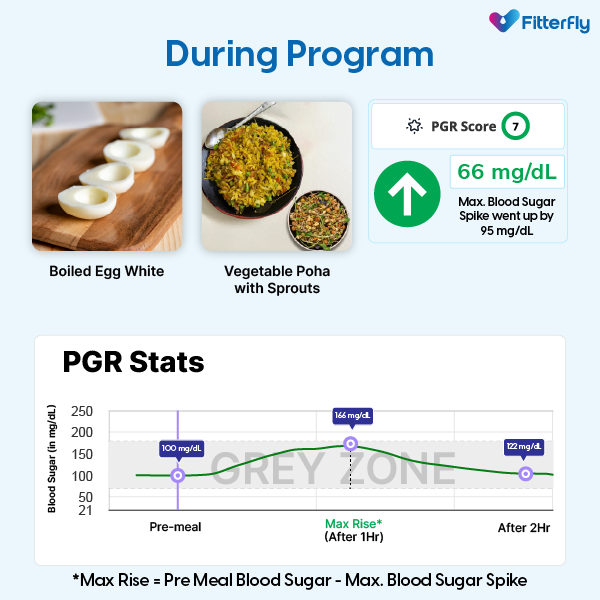

This simple yet effective adjustment allowed the member to enjoy his favourite poha breakfast without compromising his health. All thanks to PGR!
How Fitterfly Helps You Manage Diabetes with PGR?
At Fitterfly, we believe diabetes management should be personalized, science-backed, and sustainable – not restrictive. Using Personalized Glycemic Response (PGR) and Continuous Glucose Monitoring (CGM), we help you understand how your body reacts to food so you can make better choices without giving up what you love.
Instead of strict diets, we guide you on portion sizes, food combinations, and meal timings to keep blood sugar stable – just like Rajesh Sahu, who learned how to enjoy poha with sprouts or mango with curd without spikes. In simple, we tell you what food will WORK FOR YOU 😀
But we are there beyond food, too, our Fitness and Success Coaches will guide you with the right exercise for you, pain management, stress management, and better sleep techniques. With expert guidance and real-time insights, we can help you become a pro at managing diabetes without any cons 😀.
Call us at 08068507599 – we promise it will be one of the best decisions you can make for your health.
*Personal details published in this blog, like name, age, occupation, and health conditions, are with Mr Rajesh Sahu’s consent.
Reduced diabetes medications in 3 months


6.8%
Happy members
EMI
Guarantee
4.8/5
Diabetes Prime Program
This blog provides general information for educational and informational purposes only and shouldn't be seen as professional advice.
Frequently Asked Questions
Would the personalised glycemic response be based on exercise too?
Yes, just like different foods increase/decrease blood sugar levels at different rates, exercise does too. Weight training, cardio, or functional training all affect blood sugar levels differently. That is why it is important to check PGR after workouts.
How do I check my personalised glycemic response?
Checking and recording your blood sugar regularly through a Continuous Glucose Monitoring (CGM) device or a glucometer is the first step. To determine your personalised glycemic response, the values should be correlated with the readings and your diet plan with the assistance of your diabetes coach.
Which is better, wheat or rice?
It varies from individual to individual. The personalised glycemic response provides the most reliable evidence to address such questions. Some people have stable blood sugar levels with both, some with just one, and some with neither. To know how you respond to wheat, rice, or any other grain, you need to record routine blood sugar levels and follow your diabetes coach closely.











